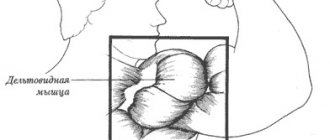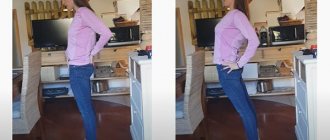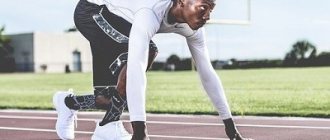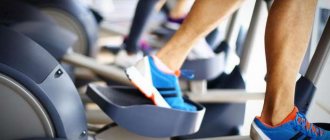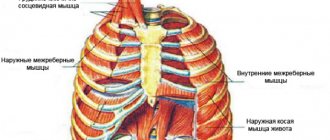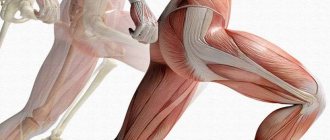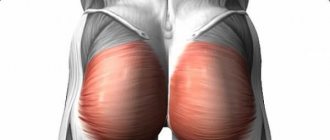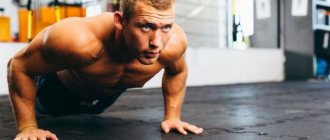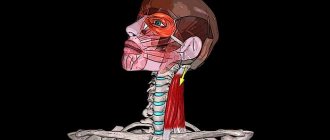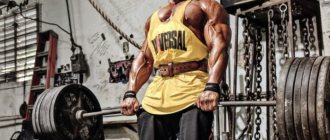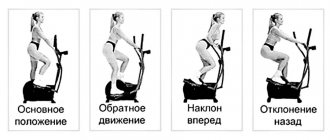Everyone, without exception, dreams of a beautiful and toned body. Some people go to the gym, work out and work on themselves, while others sit in one place and wait for good results.
You can also keep your body in beautiful condition at home. There is no need to give up food, you need to move and turn fat deposits into elastic muscles. For example, men can try rocking their back. It contains the teres major muscle. It helps the entire shoulder joint work.
How to practice
If you're working your entire body in one workout, choose an exercise for each muscle group. If you prefer splits, take two exercises from each point and add them to your back day or deadlift day.
Some of the exercises described in the article pump up several muscle groups at once. Take this into account when creating your program. For example, you can choose one that will work both your upper and lower back well, or work these areas separately.
Select the weight of the equipment in such a way that the last repetitions in the approach are difficult, but without compromising the technique. The number of sets and repetitions will be indicated for each exercise.
If the movement is performed with body weight, do it as much as you can.
How to do exercises for the latissimus dorsi muscles
These exercises will also help target the trapezius, rhomboids, infraspinatus, teres major, and teres minor muscles.
Upper pulley to chest
You can tilt the body back a little and lock it in this position. Fixation is of great importance: if you want to fully load your back, swinging must be eliminated.
Lower your shoulders and squeeze your shoulder blades together, pull the handle until it touches your chest, and then smoothly and under control return it to the starting position. There is no need to A Comparative Analysis and Technique of the Lat Pull-down raise your shoulders to your ears at the extreme point - keep them down and your shoulder blades retracted.
Perform 3-5 sets of 10-12 reps.
Pull of the lower block to the stomach
In addition to the lats, abdominal rows work well Variations in muscle activation levels during traditional latissimus dorsi weight training exercises: An experimental study of the middle trapezius and rhomboids. Therefore, if you want to pump up both the upper and lower back with one exercise, include this option in your workout.
Sit on the machine, place your feet on the platform, and grab the handle. Lower and straighten your shoulders, straighten your back. As you exhale, pull the handle toward your stomach, then return it to the starting position and repeat.
Do not jerk your back or lean back: only your arms move throughout the entire exercise.
Do 3-5 sets of 10-12 reps.
Incline Pull-Ups
Another universal exercise that works well on almost all back muscles. Unlike regular pull-ups, it is suitable for any level of training: just change the position of the body and legs, and even a beginner can do a pull-up.
Find a low crossbar. If you work out at the gym, you can use a barbell on racks. Grasp it with a straight grip slightly wider than your shoulders: this position of the hands will more engage the latissimus dorsi and trapezius muscles. If possible, do inclined pull-ups on loops or rings - this will increase the load on your back Effects of hand-grip during the inverted row with and without a suspension device: An electromyographical investigation.
Hang on the selected apparatus, tighten your abs and buttocks, and stretch your body in one line. Lower your shoulders and squeeze your shoulder blades together, pull yourself up until your chest touches and lower back down.
You can simplify the exercise in two ways: find a higher bar so that your body is in a more vertical position, or bend your knees at a right angle and place your feet on the floor.
Incline pull-ups can be made more difficult by using elevation. Place your feet on the stand so that your body is in a horizontal plane.
Perform 3–5 sets of 15–20 reps.
Straight grip pull-ups
Grasp the horizontal bar, lower your shoulders and squeeze your shoulder blades together. Pull yourself up so that your chin goes beyond the level of the horizontal bar, lower yourself back down and repeat. When doing pull-ups, do not jerk or swing. At the top point, do not pull your chin up to reach the horizontal bar; at the bottom point, keep your shoulder blades retracted.
You can make the exercise more difficult by wearing a weight belt. Instead of simplifying, it is better to replace it with lat pull-downs or Australian pull-ups.
Useful exercises for the back
A great variety of useful physical practices for the back have been invented, let's look at the most famous and effective of them.
Classic pull-ups
Pull-ups are great for developing the muscles of your arms and back.
- Grab the bar with an overhand grip slightly wider than shoulder width.
- As you exhale, slowly raise your body, bringing your shoulder blades together.
- Touch the bar with your chin or upper chest.
- We fixate at the highest point for a couple of seconds.
- Taking a breath, we gradually lower ourselves.
- We perform 8–15 repetitions.
Hyperextension is the best exercise to strengthen your back muscles.
Hyperextension is by far one of the best exercises for the back muscles. When you first meet it, it may seem that it does not require much effort and is easy to perform. In fact, it is, but only after you learn how to do it correctly.
The benefits of such physical activity are as follows:
- hyperextension works the lower part of the latissimus dorsi, gluteus maximus and minimus, and hamstrings;
- tones the main muscle groups of the body and legs;
- trains the spinal erectors, thanks to which posture is corrected;
- the functioning of the circulatory system improves;
- metabolism accelerates, toxins are eliminated from the body faster;
- bones and joints become stronger.
Despite the serious requirements, this exercise is recommended for both women and men, and those who have not previously trained, and those who experience back problems. For the first group, hyperextension performs a preventive function, for the second - a therapeutic one, and another warm-up function is perfect for athletes who are preparing for exercises with more serious loads.
How to do exercises for the trapezius muscles of the back
Barbell row to the chin
Do 3-5 sets of 8-10 reps.
Reverse dumbbell swings lying on your stomach
Lie on your stomach on an incline bench, take dumbbells, turn your hands back to front. As you exhale, spread the dumbbells to the sides, while simultaneously turning your hands with your thumbs up. Lower back down and repeat.
Do 3-5 sets of 10-12 reps.
IYT climbs
Lie on your stomach on an incline bench, hold dumbbells in your hands. As you exhale, raise your arms above your head with the backs facing up and then lower them to the starting position.
Now raise your arms up diagonally so that your posture resembles the letter Y, with your palms facing upward with your thumbs. Lower to the starting position.
Then spread your arms out to the sides with your thumbs up so that your body resembles the letter T. Lower to the starting position. This was one approach.
Do the same 3-5 times for 4-5 repetitions.
How to do back extensor exercises
These two best exercises are Trunk muscle activity during stability ball and free weight exercises; Muscle activation during various hamstring exercises for the back extensors work well on the entire posterior chain, including the glutes and hamstrings.
Deadlift
Stand over the barbell with the bar over the laces of your shoes. Push your hips back, bend over with a straight back, and grab the barbell with an overhand grip slightly wider than shoulder-width apart.
As you exhale, straighten your hip and knee joints, keeping your back straight. Bring the barbell close to your shins, almost touching them. Lower it to the floor and repeat.
Perform 3-5 sets of 6-8 reps.
Hyperextension on GHD
This exercise is often used at the beginning of a workout to warm up and strengthen the back, buttocks, and hamstrings.
Place your feet under the rollers of the GHD machine and place your hands behind your head. Lower your body and then return to the starting position. At the top, rise above the parallel of your back with the floor and look forward. Perform smoothly and under control, without rocking or jerking.
Do 3-5 sets of 15-20 reps.
Hold it to failure for as long as you can. Perform 3 sets.
A set of effective exercises
Pull-ups and push-ups pump up the serratus back muscles
In order for exercises to work the spinal muscles to bring only benefit to the body and not harm, it is necessary to follow safety precautions.
- Exercises should be done on an empty stomach. The interval between meals and training is at least 2 hours.
- It is necessary to distinguish burning sensation in the muscles from pain in the joints. In the second case, you need to stop doing the exercises and consult a doctor.
- The amplitude must be increased gradually. If your back is very weak, you need to start exercising strictly with your own weight. The amplitude of movements should be very small. If your back is strong, you can use various weights - for example, dumbbells;
- all movements must be slow, smooth, precise. There should be no jerks. This especially applies to individuals who have already been diagnosed with spinal pathologies. Sharp bends and twists are allowed, but they must be transferred from the back to the joints and ligaments.
There is no need to rush to make the complex. While performing the exercises, you should try to properly feel each muscle. The average training time is 10-15 minutes. Beginners should start with 5 minutes a day.
Warm-up
General body warm-up for 15 minutes
Warm-up is carried out at the beginning of the workout. On average it takes 5-10 minutes. The main task is to warm up the muscles and prepare them for exercise.
First you need to jump well in place. The next stage is stretching the joints. They need to be rotated in different directions. Direction – top to bottom.
The final stage of the warm-up is muscle stretching. You need to stretch slightly, first upward, and then to the sides, making deep bends to the right and left.
Anatomy of teres major and minor muscles
Due to its size and location, it is not common practice to pay much attention to the teres dorsi muscles in sports. However, they play an important role in the movement of the shoulder joint, which is considered not only one of the most complex in structure, but also the most vulnerable to injury.
Teres major muscle: structure and functions
The teres major muscle is oblong and flat in shape. Closely adjacent to the top of the lat, which partially covers it. Also, the teres major muscle of the back is covered by the posterior bundle of deltas and the long head of the triceps. Originates from:
- Infraspinatus fascia.
- The lower angle of the scapula (from the outer edge).
Attaches to the crest of the lesser tubercle of the humerus.
The main functions of the teres major muscle:
- Internal rotation of the shoulder (pronation).
- Shoulder adduction (with arms raised).
- Shoulder extension.
Teres minor muscle: structure and functions
The teres minor muscle has an oblong shape. It is closely adjacent to the infraspinatus with its upper edge, and is also partially covered by the delta. The teres minor muscle acts as an antagonist to the major muscle, performing the opposite task.
- Starts from the lateral edge of the scapula (from the subarticular tubercle to the lower angle of the bone).
- It is attached to a powerful tendon and fuses with the capsule of the shoulder joint (posterior surface).
Functions of the teres minor muscle:
- External rotation of the shoulder (supination).
- Stabilizes the shoulder joint (together with the supraspinatus, infraspinatus and subscapularis) when the arms are abducted to the sides.
How to train the teres muscles
In sports, it is not customary to perform separate movements for the teres major muscle. The same applies to the teres minor dorsi muscle as an antagonist. However, their underdevelopment often causes serious shoulder injuries, so it is important to understand how to provide safe and useful loading.
For targeted loading, just as during rehabilitation after injuries, focused work with light weights is recommended. This will eliminate situations where the main load will be switched to other, larger areas. Otherwise, activation of the target area occurs in any exercise in which the function of the teres major and minor muscles of the back is performed. With a properly structured training program and sufficient back work, additional movements are usually not required.
Otherwise, it is important to remember that in order to strengthen the fibers, in addition to regular training, it is necessary to provide a sufficient amount of amino acids and calories, as well as time for recovery.
The best exercises that involve the teres muscles
In many exercises, the teres major dorsi muscle is automatically activated, so performing basic basic movements allows you to fully load the desired area. The same applies to the small one as an antagonist.
T-bar row
A very effective movement for the entire back and shoulder girdle. The exercise uses the teres major muscle. The T-bar row allows you to safely work even with heavy weights, and therefore is able to provide maximum speed of progression.
Technique:
- Stand over the bar (or on the foot platforms, if performed in a special machine) and grab the handles. Bend as low as possible (up to a right angle between your legs and body), but only while keeping your back straight.
- Begin with a powerful movement to pull the bar as close to the body as possible.
- Take a short break and slowly lower the projectile to the starting position.
It is important not to “drop” the bar on the floor or the clamps between repetitions. Hold it so that you maintain tension throughout the entire set. It is also necessary to eliminate the role of the biceps as much as possible so that it does not take up the bulk of the load.
Horizontal block pull (V-shaped handle)
One of the best movements for the lats, traps and rear deltoids. Ideal for pumping up the teres major muscle of the back, but only when working with a V-shaped handle.
Technique:
- Sit on the bench and rest your feet on the platforms. Knees slightly bent, back straight. Move the handle so that tension is felt in the initial position.
- At a moderate pace, pull your hands towards your lower abdomen.
- To increase the range of motion and improve its effectiveness, lean back 10 degrees.
- Hold for 0.5-1 second with your shoulder blades retracted (chest forward), then return the weight to the starting position.
- It is important to prevent strong body swaying.
- The optimal deviation back and forth is within 10 degrees.
- The back should be straight throughout the entire approach.
- It is also recommended to “turn on” the biceps not in the initial phase of the movement, but to bring the handle closer to the body as much as possible.
Bent-over dumbbell row (one arm)
Another incredibly useful exercise. Its main advantage is that the movement can be done with each hand separately. This allows you to increase the amplitude and provide the most effective load.
Technique:
- Place one knee on the bench, then tilt your body forward and rest your palm on it. The back should be straight. The dumbbell is held with your free hand (brought as close to the body as possible).
- Begin to bend your arm at the elbow and pull the projectile towards the lower abdomen (closer to the beginning of the thigh).
- At the top point, move your shoulder blade back as far as possible, pause and slowly return the weight to the starting position (without straightening your arm completely).
In the exercise, it is important that the movement of the arm occurs as close to the body as possible. It is also necessary to securely fix the position of the body to prevent swaying and switching the load to other groups.
Consistency is the key to success
When the body is forming, at first the muscles swell after intense physical activity. This is typical for every organism. When performing exercises, muscle fibers stretch, lactic acid accumulates in them, hence the pain. There is nothing to worry about here, over time everything will return to normal.
Now you have the necessary knowledge on how to pump up the teres major muscle and the rest of your back. The main thing is to go towards the goal without stopping halfway. To get a beautiful, sculpted and toned body, you need to spend a lot of time and effort. You may have to study for several months, or maybe it will take up to a year, and then you simply won’t be able to stop. The habit of having a beautiful and fit body will remain.
Classes must be conducted regularly. If you are at home, then you need to do the exercises every day, giving rest once every two weeks. If you work out at the gym, you need to make a schedule for visiting. You need to go there twice a week. It’s much easier and faster to build muscles in the gym, but it’s also possible at home. You just need to want to transform your body and bring it to perfection.
Video: Back workout with dumbbells. 5 exercises
https://youtu.be/4FLDwkvYBTI
The deep paravertebral muscles ( spinal-sacral ) form the so-called “muscle corset”, which serves to maintain the normal position and curves of the spine, the position and movement of individual vertebrae relative to each other, and are involved in maintaining stability.
There is not a single movement in our life in which the back corset - hence the importance of their strengthening and development, as well as a correct understanding of their involvement in the physical work of the body.
Functional task
Each muscle bundle has its own task. The teres major muscle is no exception; it performs functions such as:
- pulls the upper limbs towards the bottom and back;
- provides rotational movement in the inner direction;
- responsible for bringing the arms to the body.
Due to the fastening features and functional tasks, the large round one is involved in the main work of the shoulder girdle, ensuring shoulder mobility. If, for some reason, an inflammatory process begins in these tissues, then the person immediately feels painful spasms while raising the limbs upward. Injury is the main negative factor in the disease of the orbicularis major muscle. Since this muscle is actively involved in the work of the shoulder girdle, it is constantly exposed to increased physical stress. Almost all hand movements are performed with her participation. Among the most common pathologies diagnosed are myositis and myalgia. Diseases appear as a result of increased stress without special training, as well as during severe hypothermia of the body, stressful situations, intoxication, various lesions of the spinal column, and improper distribution of load during physical work or the training process.
Only a doctor can determine an accurate diagnosis after palpation and testing. As a rule, pain-relieving ointments are prescribed as treatment, and therapeutic exercises aimed at stretching the fibers and then strengthening them are prescribed. In severe cases, drug therapy is recommended, including injections, tablets, gels, massage and physiotherapy. Proper treatment will help you get rid of discomfort in the near future.
https://youtu.be/vp7greGkNv4
Latissimus dorsi training
https://youtu.be/OStKrVHE3F0
Upgrading the width
To train your back in width , it is recommended to perform the following exercises
Pull-ups require a certain amount of physical strength and are great for developing the teres major and latissimus muscles, and, at the moment of retraction of the shoulder blades at the end of the pull-up, the rhomboids.
This movement develops the latissimus and teres major muscles. His efforts also extend to the biceps and shoulders.
This exercise increases the width of the core, using the trapezius, rhomboids, biceps and deltoids.
This exercise perfectly develops the broad back, its upper and lower bundles, as well as the large round muscles.
This is an excellent exercise for fully developing the teres major and latissimus dorsi muscles . When bringing the shoulder blades together, the rhomboid and trapezoid muscles are involved, as well as the back parts of the shoulder deltas.
Exercise to work your back. It perfectly loads the lats, includes the lower part of the trapezius, uses the round and rhomboid muscles of the back, as well as the rear delta, biceps and forearms.
This exercise also works the latissimus and teres dorsi muscles. Swimmers often use this exercise as a strength exercise, allowing them to get good results in the crawl style.
Exercises in the gym
In order for the teres major muscle to be pumped up, the gym is the most suitable solution. It is necessary to choose block exercise machines that make your arms work. This works the back muscles. The most common simulator is called the “butterfly”. With constant exercise on it, the relief of the spinal muscles is more pronounced and resembles a winged insect. When practicing, it is necessary to perform the exercises correctly for more effective results. It is better to turn to professionals who know all the intricacies to obtain an excellent effect.
In the video: wide grip lower block rows
https://youtu.be/1NNNrPc4GlM
Back thickness
The following exercises primarily load those parts that develop the thickness of the back. If you want to have a thick and massive body , focus on these exercises in your program.
This exercise perfectly forms thickness, using the teres major and latissimus dorsi muscles, and the posterior fascicles of the shoulders.
This exercise primarily targets the latissimus dorsi , teres major, posterior deltoids, and rhomboids and trapezius in the final phase of the movement.
This exercise engages the teres major and latissimus dorsi, the back of the deltoids, the arm flexors, and when bringing the shoulder blades together, the rhomboids and trapezius.
This exercise primarily loads the teres major and latissimus dorsi muscles and the posterior fascicles of the shoulders.
This row concentrates the load on the back without requiring significant effort to maintain correct body position.
This exercise allows you to focus on the back muscles and requires much less effort to maintain the correct body position.
This basic exercise perfectly works the latissimus muscles.
Suitable for both beginners and experienced athletes. It works well on the technique for beginners, since the movement occurs along a given trajectory of the simulator.
Reasons to build muscle
- When a person’s back muscles are well pumped, the strength in his arms increases, and he can lift very heavy objects.
- Having a body with prominent muscles, a person feels much more admiring glances; he is always the center of attention.
- By constantly improving your body, you can strengthen your spine, because playing sports is the key to health.
In order for the teres major muscle to be normal, exercises should be selected more carefully. Mostly there should be traction (lifting a heavy load). This is the most effective way to swing. And, of course, the horizontal bar.
Trapezius workout
https://youtu.be/R_R1zlywv_k
Vertical raises work the trapezius, mainly the upper part, as well as the deltoids and levator scapulae muscles.
Shrugs are the basis for training the upper trapezius , mainly including its occipito-clavicular fascicles, as well as the scapular.
The dumbbell shrug is designed to work the upper or clavicular trapezius, levator scapulae, mid rhomboids, and trapezius when complemented by shoulder lift by scapula closure.
This exercise, when used consistently, is excellent for developing the upper trapezius and levator scapulae muscles.
Back training program
It should be built according to the following principles:
- include horizontal and vertical thrusts;
- performed in 4-6 repetitions;
- pump up your back through basic exercises with heavy weights.
Another important point is the preparation of the athlete.
For newbies
The program includes:
- Warm up 5-10 min
- Pull-ups 4x6
- Deadlift 4x6
- Bent-over barbell row 4×6
- Cool down (muscle stretching)
Those athletes who cannot do five pull-ups with perfect technique should do vertical pull-downs. The main thing is not to mess around. The execution must be perfect and the working scales must be heavy.
For intermediate level
It differs from the program for beginners by the introduction of another exercise that develops the latissimus muscles - one-arm dumbbell rows. It is done in 3 sets with 8 repetitions in each.
Athletes who have a good mass, for deep development, can resort to another version of the program, consisting of:
- Warm up 5-10 min
- Pull-ups 4x6
- Deadlift 4x6
- Bent-over barbell row 4×6
- One-arm dumbbell row 3×8
- Cool down (muscle stretching)
Or this (for athletes with available muscle mass for deep development):
- Warm up 5-10 min
- Vertical block pull 4×6
- Row T bar 4×6
- Horizontal block pull 4×6
- Shrugs with dumbbells 3x8
- Cool down (muscle stretching)
Each athlete chooses the best workout for himself, taking into account his primary goal.
For experienced athletes
The program may include:
- Warm up 5-10 min
- Pull-ups 4x6
- Bent-over barbell row 4×6
- One-arm dumbbell row 3×8
- Horizontal block pull 4×6
- Shrugs or deadlifts (optional)
- Cool down (muscle stretching)
The advanced training program includes one exercise for the trapezius and four for the latissimus muscles. The main idea is that the intensity of your training increases. You can increase the number of exercises, reduce rest after approaches, use super series or drop sets.
